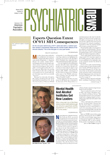The Hamilton Rating Scale for Depression has become a universally accepted and widely used measurement tool since it was introduced in 1960. Many psychiatrists who are familiar with the rating scale are, however, unfamiliar with its developer, Max Hamilton, M.D.
Hamilton had an undistinguished career during his first 20 years in general medicine and psychiatry, but his concern for patients and for “scientific objectivity” made lasting contributions to clinical trials, rating-scale development, and the pioneering use of factor analysis and other statistical methods.
Hamilton was born in Germany and moved to England with his family at age 3. Secondary schooling in London gave him a solid background in mathematics, and he went on to obtain a medical degree in 1934 at University College Hospital. For the next several years he was a general practitioner for elderly pensioners.
When war came to Great Britain in 1939, he enlisted in the Royal Air Force and was assigned to an engineering unit in England, many of whose personnel had been placed there because of emotional problems. His interest in mental illness aroused, he began to read psychology, and after the war ended he entered training in psychiatry.
He started his psychiatry training at Maudsley Hospital, where he was not retained. (“I never understood why Sir Aubrey Lewis did not like me,” Hamilton commented.) He also had short-term jobs at Kings College and University College Hospital. It was at the latter hospital that he came under the tutelage of Sir Cyril Burt, a well-known research and statistical psychologist, during which time he honed his research interests and skills.
He accepted a job at a state hospital near London, caring for patients by day and devoting his evenings to psychological endeavors, which led him to apply scientific methods to his work with patients. (His continuing involvement with psychology later led to his presidency of the British Psychological Association in 1973.)
In 1953 he went to the medical school at Leeds as senior lecturer. He worked his way into full-time research and began his studies on his anxiety and depression scales.
In 1959 he spent a year at the research unit at St. Elizabeths Hospital in Washington, D.C., where he studied under Joel Elkes, M.D. (Hamilton noted in a 1982 interview that the young psychiatrists doing alternative service and assigned to the research unit were busy getting psychoanalyzed and preparing for private practice.)
He returned to Leeds to continue his research endeavors and in 1963 was elected chair of the psychiatry program there, which led him into psychiatric education. He redesigned the medical-student curriculum to teach the students how to deal with the emotional and psychiatric problems of patients and their families. He also expanded postgraduate programs in psychiatry, social work, and psychology. He retired as chair in 1977.
Hamilton published two books, a small volume in 1955 titled Psychosomatics, which applied psychometrics to ulcer problems, and in 1974 Lectures on the Methodology of Clinical Research. He edited new editions of three books by Frank Fish, a psychopathologist.
In 1983 the Bulletin of the Royal College of Psychiatrists published a long interview with Hamilton, which makes him come to life as a person. At a memorial symposium of the European College of Neuropharmacology in 1989, Sir Martin Roth, M.D., chair of the psychiatry department at Cambridge University (who in 1973 was named a distinguished fellow of APA), said of Hamilton and his life devoted to psychiatric science that “his gifts were late to be recognized, and the facilities afforded him were limited. . . [but] he was able to prevail in the face of prejudice, rejection, and defeat.”
More than 40 years after its introduction, the Hamilton Rating Scale is one of the most cited references in the psychiatric literature on depression. ▪
